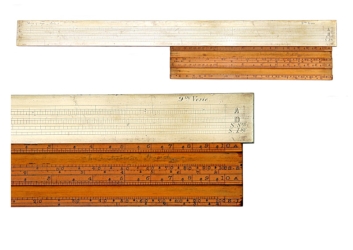Scientific Instrument Society 25th Anniversary Exhibition
Navigation:
<< First | < Previous | Next > | Last >>
29 Master for Graduating a Slide Rule
Instruments used by instrument makers are extraordinarily rare and this heavy brass rule may be unique.
The traditional method for making a slide rule was for an instrument maker to engrave the scales for the rule on a brass ‘Master’ and these graduations were then transferred to the wooden slide rule using a set-square and a sharp knife.
This uniface rule is engraved ‘Dring & Fage, London’ and ‘9 in. Verie.’ The scales are marked ‘A, D, S.Stg., S.Lyg.’ and were used for graduating an excise slide rule intended for the licensed victualling trade.
Displayed below it is an example of the boxwood slide rule that was made using this Master, the upper scale of which is aligned with the upper scale on the Master; both are marked ‘A’.
The ‘9 inches’ refers not to the length of the slide rule, but to the length of a single radius logarithmic line. The ‘A’ line on the slide rule is of single radius (length) while that on the Master is of double radius, thus it was possible to graduate a slide rule twice the length of that displayed.
Measuring, with a wine diagonal, the amount of wine or beer remaining in a barrel, would depend on whether it was lying on its side or standing upright. The scales marked ‘S.Stg.’ and ‘S.Lyg’, which are abbreviations for Segment Standing and Segment Lying, are used to calculate these quantities.
Two of the four sliders are displayed in the same groove, so that calculations would not run off the end of the slider. To prevent wear, small slips of brass have been let into the ends of each slider where they touch. This modification was introduced, before 1739, by J. Vero (sometimes spelt Verie), a collector of taxes for the Excise.
The instrument makers John Dring and William Fage were in partnership from 1790 and made excise slide rules and hydrometers. Their joint names continued to be used well into the twentieth century.
See: C. Leadbetter, The Royal Gauger, London 1739 p.29.
Bulletin of the Scientific Instrument Society, No. 3 1984, pp.3-10
Collection: Peter Delehar, London
Objects lent by Peter Delehar, London:
08. Circular Slide Rule on a Snuff Box, by Hoyau, Paris, 1816
11. Reversible Circular Slide Rule, English, c.1840
25. Slide Rules - a Selection of the Original Pocket Calculators
26. Javal's Ophthalmic Slide Rule, by A. Cretes, Paris, c. 1875
27. Triangular Slide Rule with Four Sliders, by Elliott, London, c. 1870
28. Oil Calculation Slide Rule Designed by Forrest M. Towl, New York, c. 1889
30. Anderson Celluloid Gridiron Slide Rule, by Casella & Co, London, c. 1903
31. Slide Rule in a Drawing Scale, by J. Casartelli, Manchester, c. 1870
32. Circular Slide Rule, by Joseph Lamb, London, c. 1827
33. Roubicek Circular Slide Rule for Surveying, by Neuhöfer & Sohn, Vienna, c. 1870
34. Annular Slide Rule, by Elliott Brothers, London, c. 1875
36. Box Sextant with Integral Slide Rule, by Troughton & Simms, London, c. 1870

